A Precarious Balance: Home Space - Pari
(Fairy)Space
- Other Forces of Nature
As part of our expedition to Hunza The Pak Khawateen Painting Club trekked
across glaciers, mountains and streams. We photographed, documented,
wrote, ate and rested in a unique environment that was unlike our own. The
topography, rituals and social organization in Hunza- in short landscapes
of everyday life- were defined in relation to different experiences of
space. As I acclimatized and adapted, not only did it become apparent that
Hunza retained a strong oral culture of story-telling but the
entanglements between culture, tradition and environment were unique, to
say the least. Lived experiences and memory narrated through cultures of
storytelling could transform natural phenomenon, functions and entire
landscapes into something magical or extraordinary. I became increasingly
interested in place-lore, a term used to describe stories that people tell
about physical and natural surroundings familiar to them. Sometimes the
place or setting being spoken about in say a folklore would be present in
the actual landscape itself. The physical environment itself would become
a catalyst for the production and interpretation of meaning i.e natural
phenomenon were explained through fantastical vernacular interpretations.
At other times ecological concerns were merged with morality and piety;
folk stories were supposed to serve as a mode of admonishment in response
to ecological imbalance created by human activity/human
greed. Since the central concern of the expedition was tied to
environmental risks and catastrophes that do not recognize geographic
boundaries established by nation-states, storytelling, it began to seem,
could traverse these limitations and elevate the narration to encompass
concerns about ecology, harmony and balance in nature. Certain cultural
and ritual practices involving the natural environment in Hunza began to
emerge almost as acts of transgression vis-à-vis state
ideologies that craft and legitimize narratives around geopolitical pasts;
after all it is nation-building that ensures that boundaries are
established and borders are maintained. Were these cultural traditions and
practices indicative of remnants of an agrarian and animist way of life
that was either co-existing or contesting space with the narratives of
salvation religions(Islam, Christianity
etc.)? The existence of beings other than divs and
churails which are either male or female in storytelling was also
fascinating. One of these beings was called a pari. I speak Urdu and
coming from the plains or down se (from down
there) - as I sometimes had to introduce myself in
colloquial terms- the word pari meant
"fairy" and implied a female gender.
However, Hunzakut say that "the pari appear to be the
embodiment of natural forces, displaying the life-giving and
life-threatening attributes of the mountains. Hunzakut say that the pari
jealously guard their domain against human encroachment. This is why the
Hunzakut traditionally regarded the up- land pastures and the mountains
beyond as sacred places, the hallowed domain of the pari...these
supernatural beings are offended by the presence of women
(believed to be impure because of their menstrual periods)and
cattle (from down there)
."(i)
The pari then can be considered akin to capricious, animist spirits that
eschew gender and maintain order in the spirit world that pertains to
nature. Interestingly I did document stories where the pari was given
certain human qualities indicating their malleable identity that was
informed by context and environment. To elaborate on how I then
interpreted the term pari and incorporated it into my title I turn to
James C. Scott and his book "The Art of Not Being
Governed." James C. Scott considered the hill-people of
zomia (a geographic region that is located at an altitude
which is above three hundred meters and encompasses Southeast Asia, East
Asia, South Asia) as being evasive of state-making
ideologies.(ii) (iii) The people of Hunza with their
animistic rituals and oral folklore carry similar tendencies. The flexible
use of the word pari also implies resistance to fixed identities informed
and constructed by nationalist ideologies.
To me "Pari-space" therefore represents
an imaginary refuge much like zomia, it is transformative and in flux. It
is, of course cultural heritage but perhaps also an intangible
manifestation of what might now in modern times be considered,
transgressive activities, that nevertheless still inform the cultural
memory and life of the people of Hunza. Unfortunately, climate change and
the frequency of environmental disasters such as
(GLOFS) threaten this symbiotic
relationship between place-lore, land and people.
The first half of this essay examines, cultural rituals, snippets of
interviews and conversations with residents of Hunza which I felt, carry a
consciousness of environment, ecology and history. Could some of their
stories be considered place-lore that is integral to understanding and
valuing the endangered natural resources of Hunza? If their rituals carry
the imprint of older animist cultures then will global warming affect
everyday life and the transmission of this knowledge in Hunza? In the
second half of my essay I discuss the works of two artists, one from Hunza
and one from the princely state of Nagar. Both artists draw on the
cultural memory of Hunza-Nagar in some capacity, they use
environment-related or culture-related stories to generate interest about
transnational identity, nature protection and cultural heritage. Are South
Asian artists acknowledging these histories and weaving them into their
artistic practice with an awareness of place-lore and ecology?
Mujeeb is a graduate of the National College of Arts, Lahore. He currently
manages the Altit Hunza Music School located inside the Royal gardens of
Altit Fort. We were able to witness the shamanistic practice of Bitan
owing to the efforts of Mujeeb and his friends who located a practicing
shaman and accompanied us to the ritual. Bitan was described to us as an
experience where the shaman would serve as a seer, prophesying and
describing our futures. Broadly speaking shamanism is described as
religious functionaries who draw on the powers in the natural world,
including the power of animals, and who mediate usually in an altered
state of consciousness, between the world of the living and the world of
the spirits- including the spirits of the dead. (iv)
In this particular experience with a shaman there was no visible evidence
of the use of the power of animals. We were seated in a room and watched
as the shaman lit and inhaled the smoke of juniper tree branches before
going into a curious trance-like state. He intoned mostly without pause in
an old dialect of Shina which was, oddly enough, intermingled with
recitations in Arabic. Mujeeb explained that Shina was also called
" the language of paris" and it was the
paris that were relaying all this knowledge to the Shaman. Any attempt I
made to ask whether that meant female or fairies was met with a matter of
fact reply: "They are just paris." (vi)
Sajjad Roy, a practicing artist originally from Hunza explained the
practice of Bitan, as a performative act that was conducted outdoors and
integrated natural landscape and animals into ritual. He elaborated that
once upon a time it was shamans who could predict when the crop was to be
harvested and when the ceremony of Ginani was to commence. Roy recounted
the incident of a famous shaman "who went into a mountain
with an empty thaali. When he came running out of the same mountain the
thaali contained grains of wheat, a ball of kneaded dough made from wheat
and a prepared flatbread. The shaman then announced that Ginanai could
begin." (ix)
Roy's other recollections of Bitan are more visceral.
"The Shaman performs in a crowd. He drinks the blood
from a goat 's severed head as if using it as a
vessel/container. To us it is seems grotesque but to the
Shaman it feels like he is drinking milk that comes from the horn of rams
brought by the paris themselves. " (x)
Roy too, parried the question of gender and any description of this
supernatural being.
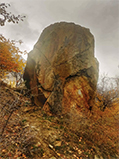
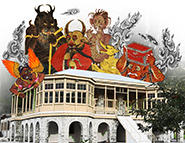
Asad Bhai, as he liked to be called, was the caretaker of our rest
houses
in Gulkin and Aliabad. He often attempted to regale us with late
night/after dinner stories about supernatural beings. Many of my queries
were met with enthusiasm, the prelude consisted of an elaborate
narration
of geographic location, a description of natural topography followed by
the actual answer to my question. However, on the question of paris,
gender and description Asad Bhai was hesitant and said he had no
definite
answer. The importance of harvest, mountains and even juniper in
conversations with Roy and Mujeeb signify the relationship of place-lore
to symbols that represent the potent powers of nature and geography.
Paris
emerge as genderless beings in these accounts. Roy recalled another
entity
with an ambiguous gender identity called dado-puppo when he relayed
that
"...there was a huge boulder near my house... In
winters
as a child I remember we would sit on that rock and eat traditional food
called mool. Since we sat and consumed the food on the rock it was as if
we were feeding the dado- puppo." (Fig. 1)
What is the dado-puppo exactly? I asked.
We could consider it the spirit of an elder nut not a jinn. Dado means
elder or old while puppo means old sage. (xi)
This was more than just a local, vernacular explanation for the
existence
of a rock. Roy ended by saying that the boulder should never be moved
because it had a spirit and that it consumed food just like humans.
Implicit in this place-lore was a warning and lesson: every rock and
boulder had a meaningful existence. Nature was being sustained by a
fragile balance. These world views appeared to be informed by cultures
and
religions such as Buddhism , Taoism/Daoism that had
travelled across the Silk Route hundreds of years ago and nourished the
cultural landscape of the region. Interestingly in another folklore
story
Roy went on to attribute other human qualities to supernatural beings as
well.
When we have sudden windstorms that last about 20-30 minutes and there
is
alot of sand, it tells us that the dado-pupo and pari are getting
married (they are mating and the sand is providing a
cover of modesty). (xii)
Asad Bhai, the caretaker of our resthouses at Aliabad and Gulkin
explained
the existence of ancient trees and boulders in Chatorkhund located in
the
westernmost part of Gilgit-Baltistan in the following words
There is a place in Ghizr called Chatorkhund where a famous Shah sahb
"he has passed away" known for his
intellect , piety and contribution to society...he gained fame for
capturing a div notorious for harassing villagers in the area...Shah
sahb
made him work, the div is known to have picked up huge boulders and
placed
them there near where Shah sahb ' s house was. The
boulders form a sort of wall. There are also huge trees near Shah sahb
' s house. It is said the Div picked them up from
another
area and planted them there. They still exist. The size, shape and age
of
those trees and boulders should tell you how ancient they are and that
it
was impossible for anyone except a div to have lifted those.
(xiii)
Such examples of place-lore contain many environmental signs, perhaps
they
not only help explain the occurrence of unique natural phenomenon such
as
a change in seasons, weather etc. but could also relay knowledge about a
sensory experience. These stories and practices could also suggest that
it
is the untamable and whimsical nature of the landscape that prompts
their
instinctive response; it highlights a more reciprocal relationship
between
man and nature. Abstract emotions such as shock, awe, wonder and mystery
are inscribed as a sort of subtext within these stories, they provide
clues about the emotional connection that inhabitants build with
landscape. While paris and their gender remains ambiguous, the oral
narratives by some of my other interviewees were charged with
descriptions
that ascribed gender, socially constructed relationships and even human
attributes to the natural environment.
Wazir Iman, a resident of Hunza who had been working closely with UNDP
on
disaster management of Glacier Lake Outburst Floods (GLOF)
delved into his experience of walking
on glaciers and noting the effects of climate change. He decried the
rapid
rate at which the sides of glaciers were atrophying and melting, leaving
behind rocks from moraine that would either block the path of
floodwaters
or come crashing down as landslides. (xiv) On being
asked about the GLOF that had occurred recently , just a few months
before
we arrived and how a hotel had been washed away in Kalam, Khyber
Pakhtunkhwa, Iman responded Woh uska haq tha, woh uska rasta tha
(xv) translated as " it was the right
of
the river, that path belonged to the river." This
particular line as well as many of Iman’s other descriptions of water,
paths and rivers expressed the kind of protective affinity or bond he
had
established with the natural environment: he had imbued it with human
qualities such as the ability to reason, decide and think. He was
willing
to speak up for the "rights" of water
as
if it was a living breathing being. Iman sympathized with the waters of
the GLOF as if they were a human entity of sorts stating that man had
made
the life of these melting waters difficult by blocking their way and
artificially attempting to control and restrict their path.
(xvi) He then poetically elaborated on how glaciers
are
in a constant state of parting and union. They recede every seven years
and grow back another seven years. It was described as a process of
yearning to meet and mate. Shishper and Batura glacier was male, Passu
was
female."Perhaps the meeting of their melting waters is
as
close as they can get to mating" (xvii) said Iman
eloquently. Such place-lore perhaps illustrates the more symbiotic
relationship between traditional communities and their environment,
"between tangible reality and the
storyworld." This creative impulse helps foster empathy
and engenders an
ecology of care where man gains the capacity to acknowledge the eco
system
as a living breathing entity. In this storyworld genders, relationships
and personalities are inscribed on the geography and natural
characteristics of the environment itself.
The storyworld can also help reveal place continuity: Iman referred to
an
actual traditional practice called paewuund kari (xix)
or glacier grafting as a more practical interpretation of
"mating" glaciers. Glacier grafting
involves growing a glacier. As far back as the twelfth century glaciers
were grown in villages in what is now known in northern Pakistan in
order
to block mountain passes that the Mongols would use to enter and invade
land. The practice of glacier grafting was invented by the people of
Baltistan. It involved dragging ice from a female glacier and a male
glacier, both pieces were planted at a specific site. Iman merged
place-lore with cultural practice in his conversation and provided an
antidote to maintaining place continuity. In doing so he highlighting
how
"the narrative potential of certain motifs of stories
may
be activated" when cultural heritage "
and in this case it is natural heritage" becomes
endangered. Belief narratives can also perform the same function. In
such
stories "Places also hold their inhabitants within
their
boundaries and order them protection, bringing people
together" (xxii) Wazir Iman narrated how a hunter in a
forest mistakenly shot a female ibex and the paris cursed him in
response.
He had murdered an animal that contained the ability to give life. Such
narratives reveal human misdeeds and the wrath of deities at upsetting
the
delicate balance that protects the environment.
My observations kept circling back to the dire environmental warnings
that
were inherent in the place-lore and imagination of inhabitants. Nearly
all
oral stories were underscored by an ominous realization: storytelling in
hill people is intertwined with a delicately woven web of nature related
materiality. Climate change could change the space and place
configurations of zomia and the zone that I have designated as pari
space.
Was it even a zone? Fluid, welcoming and imaginative as its constituents
were, it could not remain a "place" or
space for refuge if its ties to its muse were severed. The continuity
and
existence of pari space that contains genderless deities and shamanistic
practices rooted in transgressive acts (if we consider
nation states with their hegemonic narratives in
comparison)
were all tied to the recognition of the natural environment and a sense
of
place. Sense of place is a concept in heritage that allows for a lens
that
"integrates landscape and culture, the past and the
present, the movable and immovable, tangible and
intangible…" (xxiii) In this case the rituals and
storytelling help maintain the place distinctiveness, place continuity
and
an awareness of the self as a component in a much larger tapestry of
existence in Hunza. (xxiv, xxv)
Numerous ideas were percolating in my mind as I considered my initial
misgivings about understanding, challenging and imagining gender in
paris
as a mere tourist who was down se, the power of place-lore, the
fragility
of ecology and a general discomfort of state ideologies towards rituals
and practices that stray into nebulous territory. The image that emerged
from my reflection is an embodiment of this ambivalence.
(
Fig. 2) It is a
dialogue about home and identity: can we accept our multifaceted
historical pasts and acknowledge the imaginative potential of pari space
to foster a sense of place and respect for ecology? Or would the
supernatural storyworld appear as a threat to some?... an intractable
remnant from a bestial past that violates and defies dogma and societal
norms?
How, if at all, are artists from Hunza interpreting and acknowledging
these place-lore and ritual centric connections in their art? Back in
Lahore, I interviewed and analyzed the works of two graduates, Saima
Nagar
and Sajjad Roy who majored in miniature painting from the National
College
of Arts, Lahore. The visual strategies of both artists were unique.
Interestingly only one of the artists dabbled in attempts to borrow from
place-lore while the other also searched for inspiration through
possible
intra connections drawn from a pool of multi-ethnic ancestry and
transnational histories. Yet in one of their paintings both refer to a
common myth pertaining to the formation of Hunza; the visual
representations of both artists are distinct and ask questions about
identity and place in a world that sometimes privileges linear
histories,
borders and nation-states over varied historical imprints.
The myth that both artists collectively draw inspiration from is the
tale
of a cannibalistic king of Gilgit called Shirin Badad. As a ruler Shirin
Badad was cruel and unpopular amongst the people, he was known for
eating
babies. Legend has it that a kind prince from Baltistan secretly married
the daughter of Shirin Badad and had a son. Fearing that Shirin Badad
might harm the prince, she put him in a cradle and he floated across the
river until he was found by a woman washing clothes. Meanwhile a coup
was
plotted where Shirin Badad was killed. The prince was reunited with his
parents and became the king of Gilgit.
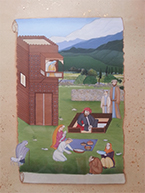
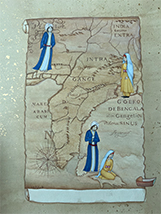

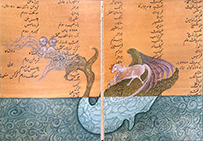
The triptych that Saima Ali shows me is part of her portfolio produced
as
an undergraduate student at NCA. Nagar opts to draw inspiration from the
Persian style of miniature painting. However, the landscape in the first
part has been painted directly from photographs and depicts the dramatic
mountain views of Hunza-Nagar. (Fig.
3)
Rather than opting for flat backgrounds or imaginary curling hilltops
often painted in multihued tones, Ali deliberately applies Eurocentric
conventions of painting such as atmospheric perspective where snowy
hilltops are bathed in hues of blue so as to represent recession of
space.
The foreground depicts a wooden building not too dissimilar to the ones
visible in traditional Persian miniature painting but Ali explains that
wooden architecture such as this is common in Hunza-Nagar. The scene
assumes we are familiar with the narrative: Shirin-Badad reclines
comfortably outside while villagers weep sorrowfully, aware that the
infant they are holding, swathed in a blanket will soon be devoured by
him. His daughter looks on helplessly from the balcony. The second part
of
the triptych shows a map in sepia tones that illustrates the prince from
Baltistan gazing longingly at Shirin Badad. Territory and geography are
used to define distance while in the lower corner the viewer encounters
them seeing off their child in a basket set to float down a river.
(Fig. 4) In this case, storytelling
through illustration serves as a means of underscoring the distinct
architecture, geography and natural landscape of the region. Fact and
fiction are meshed together, much like the tradition of storytelling in
the region and become conduits to celebrating sense of place of the
region
itself. It is worth mentioning that Saima Ali reflects on her own royal
lineage as well as she is a princess from the Kingdom of Nagar. Nagar
and
Hunza were once princely states that bordered each other. In 1974 these
states were dissolved and today Nagar is one of the ten districts in
Gilgit- Baltistan.
She acknowledges her transnational lineage through the paintings titled
Home Roots(Fig. 5) and Transcending
Borders. (Fig. 6) The background of
both
paintings features Ali’s genealogical family tree, she proudly explains
that many of the names mentioned are also used the in the celebrated
epic
poem of Iran called Shahnamah composed by Firdowsi in the tenth century
BC. Ali traces her family’s lineage from the last Sasanian King called
Yazdegerd. It is worth noting that both paintings feature natural
elements
such as land, water and trees. The tangible and intangible intermingle
to
serve as settings for the main story: Transcending Borders
(Fig. 6) illustrates a creation myth
of
Hunza-Nagar but pictorially also draws from the Shahnamah. The qualities
of the fabled mythical bird in Persian painting, the Simorgh who carries
a
future king Zal as a baby are used to narrate a creation story. The
painting depicts twin brothers who are born conjoined at birth emerging
from the sea separated, they emerge as Hunza and Nagar riding on the tip
of a hybrid creature that is composed of glaciers, ice and water. The
calculated use of ice, water, trees and hybrid demons questions the
cognitive process of merely observing everyday reality, recording
archives
and banal facts as we know it. This storyworld imbues these elements
with
the magical or as U lo and Daniel quote Basso who aptly
puts it by saying "When places are actively sensed, the
physical landscape becomes wedded to the landscape of the mind, to the
roving imagination…" (xxvi) Adopting the style of
Persian
miniature painting and using it to exaggerate, modify, stylize and
construct a whole imaginary world that exists outside time and space by
the artist is in sync with the spirit of tradition of miniature painting
which is wedded to the idea of constructing a third reality or liminal
space that exists between the heavens and the real world.
(xxvii)
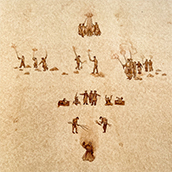
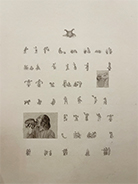
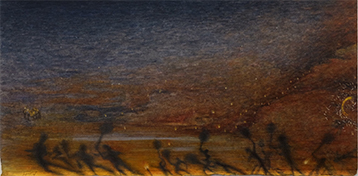

Interestingly Sajjad Roy opts for a more ethnographic approach to
framing
rituals and even storytelling. For instance, rather than the imaginary
storyworld Roy’s pictorial rendition of the tale of Shirin Badad is
presented through the use of the body and performance through the ritual
called Thumshaling. Roy pointedly states that Thumshaling is not
different
from burning effigies of Ravan on Dussehra . (xxviii)
An
effigy of Shirin Badat is burnt and people dance around a fire to
celebrate the end of his tyranny. An awareness of these connections on
Roy’s part demonstrates how stories, rituals and motifs are not just
connected to specific surroundings, but that their meanings accumulate
layer by layer, even invoking older religions and histories that add to
the multiplicity of cultural imprints. Perhaps that is why Roy’s
miniscule
figures outlined in brown pigment dance, play music and burn
Shirin-Badad
in the midst of a vast brown square of tea wash: (Fig.
7) The vast brown expanse is a canvas rooted in the
consciousness of a reciprocal relationship between land, storytelling
and
performative acts that narrate this connection. The colour of soil
informs
the colour of the figures. The more visceral and primordial aspect of
this
performance is also illustrated in another work (Fig.
8) where Thumshaling is depicted in the form of a more
subjective and sensory experience. Wavering shadows of dancing figures
and
embers of a campfire play off each other as one absorbs the untamed
landscape and multihued colours reflected across a night landscape.
In other works, Roy uses diptychs where the diagrammatic narration
through
tiny figures explains the ritual while the second part shows a more
personal connection with ritual.
Paintings such as Bitan (Fig. 9)
and Story of Bitan (Fig. 10) narrate
and
root these rituals almost in an ethnographic framework where the emotive
quality of the storyworld is rescinded in order to show the importance
of
the process. However, Roy revisits the same world and simultaneously
acknowledges it as a mysterious space where imagination and ties to
landscape can be recorded through intense, sensory experience such as in
his painting depicting a Bitan in ecstasy as he dances for the paris.
(Fig. 11) Raw, textured soil with its
many hues engulfs and compliments the scene. Once more the trance-like
psychedelic experience is exemplified by geography and landscape.
Both artists add to the rich cornucopia of what constitutes pari space
for
me; many of the acts and traditions appear to breach the frameworks laid
down by Reason, dogmas of faith and the State yet they also serve as
advisory warnings by addressing and entreating man to proceed with
caution
in this environment. The physical milieu of Hunza is defined by a desire
to pay homage to its distinct landscape through some form of creative
expression; these then reveal a web of meanings that inform lived
experiences and ensconce many worlds, little known histories.
An enduring relationship of fascination and " otherness
" when it comes to the observation and tabulation of
geography, particularly of hilly landscapes is visible even in the
memoirs
of travelers albeit in a more playful manner. In Al Qazvini’s memoirs of
medieval Iran he mentions an describes the mountain of Yaala Bashm
through
another eyewitness account. He says " One who climbed
the
mountain said to me: On it are images of creatures transformed by God
into
Stone. Among them is a shepherd leaning on a crook guarding his flock
and
a woman milking her cow, and other figures of human beings and beats.
" (xxix) As someone who was from down se I was
frequently
overwhelmed (Fig. 12) attributing them
with fantastical beings or imbuing them with magical qualities did not
seem all that unlikely after a number of treks and excursions to sites.
These examples illustrate the fact that the urge to record the
experience
of geography both in the form of a written account or even a photograph
is
tied to deeper urges; the landscape serves as muse, an object of wonder,
amusement and even awe. Place-lore has the capacity to emerge from this
wellspring of imagination.
These observations demonstrate how genius loci (xxx)
or
the spirit of a place carry stimuli that cement a unique bond with
landscape. Asad Bhai’s div at Ghizr then becomes a more tangible reality
and one can understand how genius loci may have even fueled Wazir Iman’s
evocative descriptions of glaciers as sentient or even romantic beings.
Sajjad Roy and Saima Nagar’s paintings then become archival documents
that
encode genealogies, myths and experiences in the form of ecological and
natural representations. Even living and working away from home, former
residents carry a fragment of this spirit in their creative impulses.
Unfortunately these worldviews are now under threat. Glacial melting is
accelerating every year. The International Community of Climate
Scientists
expects that 70% of the region’s glaciers could
disappear
by the turn of the century.(xxxi) As landslides, GLOFS
and other natural disasters perpetuated by climate change continue to
increase, the fate of these pockets of pari space spread across the
region, intertwined with community and life, hang in balance. This
unspoken fear now permeates everyday life across the region but
particularly in the north with its unique terrain. I remember one
unforgettable morning in Hunza where I froze midway as soon as a distant
rumbling of crumbling boulders silenced the valley of Gulkin. There was
a
pregnant pause. The birds could no longer be heard. In that what felt
like
the longest moment of overwhelming existential dread Asad Bhai scanned
the
expanse of the valley and cocked his ear to one side. Eventually his
characteristic sardonic wisdom kicked in as he looked up and said
"
these mountains and this dirt would have come down on
us by now if rain clouds had rumbled like this, bringing sheets of rain.
" Perhaps he had inadvertently voiced his greatest
fear.
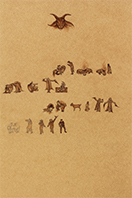
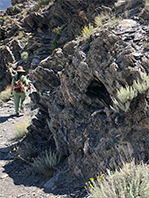


(i) Sidky, M.H. “Shamans and
Mountain Spirits in “ Asian Folklore Studies 53, no.
1 (1994) : 78.
doi:https://www.jstor.org/stable/1178560.
Hunza
(ii) Scott, “ The Art of Not Being
Governed: An Anarchist History of Upland Southeast Asia, The Art of Not
Being Governed: An Anarchist History of Upland Southeast Asia,
“ p. ix,x.
(iii) I was introduced to James C Scott’s book by Saba
who discussed it extensively during our expedition noting that farming
methods, plot organization and other characteristics in Hunza are as
James
C Scott has described for hill people.
(iv) Jolly, Pieter. “ On the
Definition
of Shamanism. “ Current Anthropology, 04, 46, no. 1
( February 2005 ) : 127
(v) Indo-Aryan language spoken in the north of
Pakistan.
It is a Dardic language that does not have a long history of written
script
(vi) Murtaza, Zohreen. Interview with Mujeeb. Personal,
October 2022.
(vii) Harvest festival celebrated in Hunza-Nagar
(viii) Urdu word for plate
(ix) Murtaza, Zohreen. Interview with Sajjad Roy.
Personal, October 2022.
(x) Ibid.
(xi) Ibid.
(xii) Ibid.
(xiii) Murtaza, Zohreen. Interview with Asad Bhai.
Personal, September 2022.
(xiv) Vince “Adventures in the
Anthropocene,“, p. 54.
(xv) Murtaza, Zohreen. Interview with Wazir Iman.
Personal, September 2022.
(xvi) Ibid.
(xvii) Ibid.
(xviii) Valk Ülo and Sävborg Daniel, p. 9.
(xix) Murtaza, Zohreen. Interview with Wazir Iman. Personal, September 2022.
(xx) Vince “Adventures in the Anthropocene,“, p. 62.
(xxi) Amos, Dan Ben. “Asian Ethnology 79-1: Review *Theoretical
Milestones: Selected Writings of Lauri Honko* (Hakamies, Pekka and Anneli Honko, Eds. );
*the Theory of Culture of Folklorist Lauri Honko, 1932-2002: The Ecology of Tradition* (Kamppinen,
Matti and Pekka Hakamies).“ AE. Accessed February 5, 2023.
https://asianethnology.org/articles/2260.
(xxii) Valk Ülo and Sävborg Daniel, p. 8.tt
(xxiii) Hawke, “ 'Belonging: the Contribution of Heritage to Sense of
Place',“ p. 2.
(xxiv) Murtaza, Zohreen. Interview with Saima Nagar. Personal, November 2022.
(xxv) Dani, Ahmad Hasan, and Akbar Hussain Akbar. Essay. In Shah Rais Khan's History of Gilgit,
edited by Abdul Hamid Khawar, 5. Islamabad: Centre for the Study of the Civilizations of Central Asia,
Quaid-i-Azam University, Islamabad., 1987.
(xxvi) Valk Ülo and Sävborg Daniel, p. 8.
(xxvii) Nasr, “Islamic Art and Spirituality“, p.
(xxviii) A Hindu festival that celebrates the victory of Rama over the demon king Ravana who
abducted Ram’s wife, Sita. The event os commemorated by burning effigies of Ravana
(xxix)Kane, Bernard O'. “Rock Faces and Rock Figures in Persian Painting,“ n.d.
(xxix) Kane, Bernard O'. “Rock Faces and Rock Figures in
Persian Painting,“ n.d.
(xxx) Spirit of a place
(xxxi) Vince “Adventures in the Anthropocene,“, p. 53,54.
Bibliography
mos, Dan Ben. “Asian Ethnology 79-1: Review *Theoretical Milestones: Selected
Writings of Lauri Honko* (Hakamies, Pekka and Anneli Honko, Eds. ); *the Theory
of Culture of Folklorist Lauri Honko, 1932-2002: The Ecology of Tradition* (Kamppinen, Matti and
Pekka Hakamies). " AE. Accessed February 5, 2023.
https://asianethnology.org/articles/2260.
Dani, Ahmad Hasan, and Akbar Hussain Akbar. Essay. In Shah Rais Khan's History of Gilgit, edited by Abdul Hamid
Khawar, 5. Islamabad: Centre for the Study of the Civilizations of Central Asia, Quaid-i-Azam University,
Islamabad., 1987.
Hawke, Stephanie. In 'Belonging: the Contribution of Heritage to Sense of Place', 2, 2010.
Jolly, Pieter. “On the Definition of Shamanism.“ Current Anthropology, 04, 46,
no. 1 (February 2005): 127.
Kane, Bernard O' .“Rock Faces and Rock Figures in Persian Painting,“ n.d.
Murtaza, Zohreen. Interview with Wazir Iman. Personal, September 2022.
Murtaza, Zohreen. Interview with Asad Bhai. Personal, September 2022.
Murtaza, Zohreen. Interview with Sajjad Roy. Personal, October 2022.
Sidky, M.H. “Shamans and Mountain Spirits in Hunza.“ Asian Folklore Studies 53,
no. 1 (1994): 78. doi:https://www.jstor.org/stable/1178560.
Scott, James C. Preface. In The Art of Not Being Governed: An Anarchist History of Upland Southeast Asia, ix,x.
New Haven, CT: Yale University Press, 2011.
Valk Ülo, and äSvborg Daniel. Essay. In Storied and Supernatural Places: Studies
in Spatial and Social Dimensions of Folklore and Sagas, 8. Helsinki: SKS, 2018.
Vince, Gaia. Essay. In Adventures in the Anthropocene, 54. London: Milkweed Editions, 2014.
Nasr, Hossein, Seyyed. Islamic Art and Spirituality. New York: State University of New York Press, 1987.